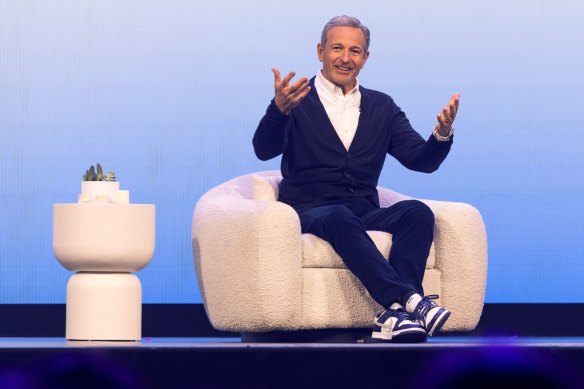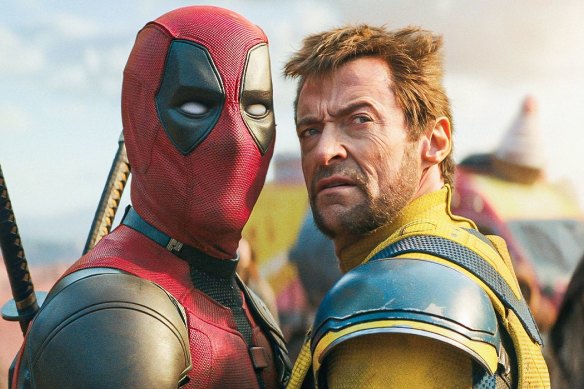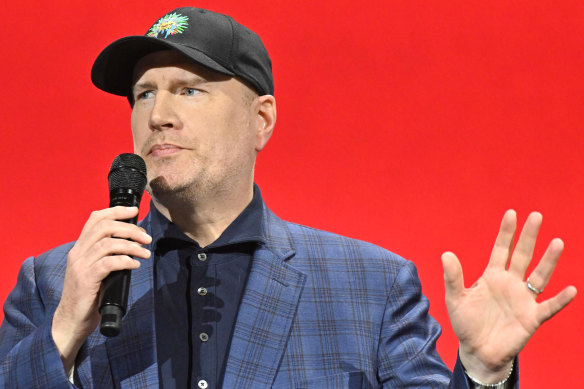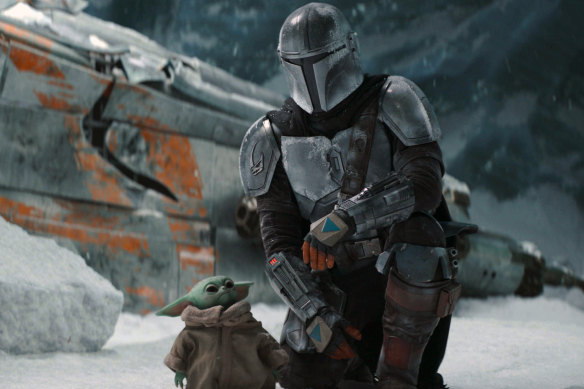As Disney celebrated its centenary last year, behind the smiles there was anxiety. A series of the company’s signature animated films – Strange World, Encanto and Lightyear – had tanked, the live-action Mulan bombed and Marvel, which had until that point batted up a run of box-office hits, stumbled with The Marvels.
The studio’s 100th birthday was a public-facing party for Hollywood’s fourth-oldest studio – only Warner Bros, Paramount and Universal are older – but in the plush-carpeted corridors of its global headquarters in Burbank, California, there was plenty of hand-wringing.

Disney CEO Bob Iger.Credit: Alisha Jucevic/Bloomberg
Retired CEO Bob Iger had returned, after two years under the unsteady leadership of his replacement, Bob Chapek, who had restructured the studio, overseen a series of decisions which rattled shareholders, and demonstrated an indifference to animation, the company’s founding craft.
A year later, to say Disney’s fortunes have turned around would be an understatement. Inside Out 2 is the highest-grossing animated movie of all time, earning $US1.5 billion, double its 2015 predecessor.
More significantly, the live-action Deadpool & Wolverine has crossed the $US1 billion threshold - an extraordinary result for an R-rated movie - and is hurtling towards $US1.5 billion. A third potential player, the animated film Moana 2, is expected to land well.

Billion-dollar bosom buddies … Deadpool and Wolverine.Credit: Disney
It would be easy to lay it all at Iger’s feet. While the fractured modern media landscape is never quite that simple, Disney’s revived fortunes owe much to the groundwork laid by Iger’s deal-making prowess.
Appointed back in 2005, the 73-year-old New York-born Iger reshaped the House of Mouse in a shopping spree that began with the acquisition of Pixar in 2006 for $US7.4 billion, and Marvel in 2009 and Lucasfilm in 2012, for $US4 billion each. In 2019, he oversaw the merger of Disney and 21st Century Fox in a deal worth $US71 billion.
Fast-forward to the box-office bounty of 2024. Inside Out 2 sprang from the Pixar label. And Deadpool & Wolverine was only made possible by the 2019 merger, which brought the two title characters, previously licensed to Fox, back under Disney’s roof. You’re welcome.
Pixar boss Pete Docter, speaking at a private media event at Disney’s D23 convention earlier this month, said there was enormous pressure to deliver. “This is not a science, this whole thing is a mystery,” Docter said. “Otherwise, we would just consistently do $US2 billion movies. It’s always a little bit of a crap shoot.
“We’re trying to make every one of these the best they possibly can be,” Docter added. “Once in a while the stars align and it happens. I think the main pressure that we feel is our own internally generated pressure to just make something as great as we can based on our own standards.”

Marvel boss Kevin Feige.Credit: The Walt Disney Company
Docter was joined by Marvel Studios president Kevin Feige, Walt Disney Animation Studios chief creative officer Jennifer Lee and Lucasfilm president Kathleen Kennedy. The mini-panel, which was not open to the public, was led by Alan Bergman, the co-chairman (with Dana Walden) of Disney Entertainment.
Feige said expectations were a dangerous threshold in an uncertain business. “We were very lucky, year after year, to exceed expectations to the point where ... within the company, or within the press, it becomes expected. It becomes expected that everything will break records.
“When we had some disappointments for the first time [last year], I don’t say it was good, but you try to find the good in everything, and one of those things is that you don’t take [the successes] for granted, you understand what you were.”
The success of Inside Out 2 and Deadpool & Wolverine was, Feige says, a reminder to “everybody that this doesn’t happen all the time, and we should celebrate it”. “That was the silver lining to having some disappointments and beginning to build yourself back up.”
The studio is not holding back its plans, with Mufasa: The Lion King and live-action Snow White and Moana adaptations coming, an unprecedented integration between the studio’s iconic characters and the Fortnite gaming world (following Disney’s $US1.9 billion investment in Epic Games) and confirmation of Toy Story 5, Frozen 3, Frozen 4 and The Incredibles 3. Sequels, anyone?
To that content pile, you can add the buzziest streaming series in recent memory (Agatha All Along), a live-action Goonies-esque Star Wars series, Skeleton Crew, the return of the Russo brothers to direct two new Avengers movies, and a decade-long planned $US1.9 billion expansion to Disneyland, the 69-year-old theme park that is arguably still the most valuable asset in the studio’s arsenal.
But all of that is not to say Disney does not have its challenges. Pixar and Marvel have both had billion-dollar babies, but stablemate Lucasfilm is struggling to fire cinematically. The fandom-rattling Star Wars “sequel trilogy” pulled in $US4 billion in total box office, but that trilogy launched almost a decade ago.
The Mandalorian demonstrated the studio’s command of Star Wars in the streaming TV world, but even there they have batted up almost as many false starts (The Book of Boba Fett, The Acolyte) as they have genuinely commercial or creative hits (Obi-Wan Kenobi, Andor, Ahsoka).

The Mandalorian and Grogu.Credit: AP
Kennedy said Lucasfilm’s shift into TV was “sort of moving into territory we didn’t frankly know a whole lot about”.
“Baby Yoda [in The Mandalorian] took the world by storm. And that was the point in time that we started saying, OK, we’re moving into a new area of storytelling in Star Wars.
“You commit yourself to doing the best work you possibly can, you try to take risk, you try to move outside of your comfort zone, and you hope that that’s going to connect with people,” she added. “When it does, it’s the most thrilling thing ever. When it doesn’t, it’s a disappointment.”
While its most valuable assets may be fictional characters, Bergman attributed the company’s success to the human beings overseeing them, saying, essentially, that Docter, Feige, Lee and Kennedy were as important to the Disney commercial algorithm as the labels they represent. “Brands, if you don’t keep them strong, weaken and go away,” Bergman said. “The people really keep them going.”
Bergman also emphasised the studio’s relationship with producer/director James Cameron, who is delivering the Avatar films to Disney, another inheritance from the 21st Century Fox merger. The first of those returned $US2.9 billion at the box office, and its sequel, 2022’s The Way of Water, pulled in $US2.3 billion. Avatar: Fire and Ash is due next year, with a fourth and fifth film coming in 2029 and 2031.
“Only six films have done $US2 billion [at the box office] and [James Cameron] has three of them,” Bergman said - Cameron’s third was 1997’s Titanic - adding that the other three belong to Feige (Avengers: Infinity War, Avengers: Endgame) and Kennedy (The Force Awakens).
“We try to make every movie a hit ... but it’s very hard,” Bergman said. “Sometimes I know right away when we have it. And sometimes, quite frankly, we’d make it the best we can, and we can’t quite get there, but that’s part of the business.”
Find out the next TV, streaming series and movies to add to your must-sees. Get The Watchlist delivered every Thursday.